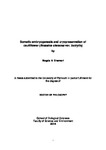Somatic embryogenesis and cryopreservation of cauliflower (Brassica oleracea var. botrytis)
| dc.contributor.supervisor | Fuller, Mick | |
| dc.contributor.author | Al Shamari, Magda | |
| dc.contributor.other | Faculty of Science and Engineering | en_US |
| dc.date.accessioned | 2014-04-11T10:06:29Z | |
| dc.date.available | 2014-04-11T10:06:29Z | |
| dc.date.issued | 2014 | |
| dc.identifier | 10216767 | en_US |
| dc.identifier.uri | http://hdl.handle.net/10026.1/2984 | |
| dc.description.abstract |
Abstract Successful efficient whole cauliflower plant regeneration via somatic embryogenesis from root derived callus tissue was achieved. The research confirmed for the first time the capability of mass production of cauliflower somatic embryos through the indirect pathway. The best callus induction and proliferation was on semi solid Murashige and Skoog (MS) medium supplemented with 2, 4-D at 0.15 mg L-1 and Kinetin at 0.1 mg L-1 and 3% sucrose. The response of different explant types (cotyledon, hypocotyls and root) through callus induction and subsequent culture was determined. The best period for subsequent callus culture was 21 days. Continuous immersion in agitated liquid medium technique was subsequently used for primary somatic embryo production. The culture requirements were empirically optimized including: explants source and size of callus tissue, blending duration, plant growth regulator combinations and concentrations as well as carbohydrate type and concentration. The highest mean number of somatic embryos (30.9) per explant was achieved using root derived embryogenic callus tissue on MS medium provided with IAA 0.05 mgL-1 and Kinetin at 0.5 mgL-1 and 2% sucrose. Somatic embryos were developed and matured on this medium and germinated with the highest percentage (60%) on semi-solid MS medium devoid of growth regulators. The culture conditions that led to the formation of secondary somatic embryos were identified. The presence of activated charcoal in the culture medium had an effect on this process but some abnormality of secondary somatic embryos was observed. Artificial seeds were produced by encapsulating the somatic embryos with a sodium alginate gel (2%) and complexing with calcium chloride (100 mM) for 20 min. The ability of these artificial seed for germination was evaluated using various combinations of plant growth regulators that were either incorporated in the artificial matrix or in the germination semi-solid culture medium. It was confirmed that cauliflower root derived embryogenic callus tissue can be cryopreserved following a preculture-dehydration technique. Following cryopreservation, embryogenic cultures can proliferate in agitated liquid medium, and somatic embryos at the globular stage were formed. Also cold storage at 5 °C in the dark was used successfully to store cauliflower callus tissue for three months without diminution of the competence for somatic embryos formation. This ability for cold storage could have a positive effect in reducing costs and efforts that result from subsequent sub-culture. The encapsulation-dehydration technique was assessed for cryopreservation of somatic embryos but failed to lead to survival of any embryos. Somatic embryos that were produced in this study were able to be well acclimated using a reliable weaning procedure that achieved high rates of survival of plantlets and their subsequent growth to normal plants in the field was assessed. Morphological characteristics of somatic plants compared favourably with zygotic plants but although there was phenotypic similarity, some differences in plant height, curd size and time for curd maturity were observed. | en_US |
| dc.description.sponsorship | Iraqi Ministry of Higher Education and Scientific Research | en_US |
| dc.language.iso | en | en_US |
| dc.publisher | Plymouth University | en_US |
| dc.subject | Somatic embryogenesis-cryopreservation-In vitro-Cauliflower | en_US |
| dc.title | Somatic embryogenesis and cryopreservation of cauliflower (Brassica oleracea var. botrytis) | en_US |
| dc.type | Thesis | |
| plymouth.version | Full version | en_US |
| dc.identifier.doi | http://dx.doi.org/10.24382/4210 |
Files in this item
This item appears in the following Collection(s)
-
01 Research Theses Main Collection
Research Theses Main


